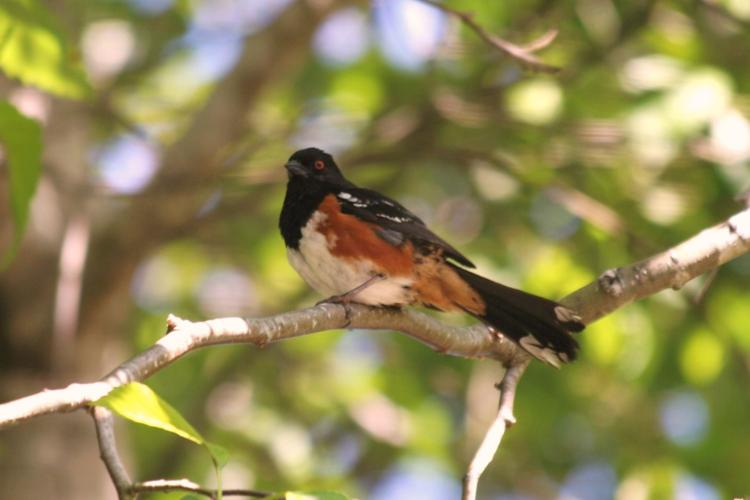Try as you might, you won’t find all of Arizona’s warblers, woodpeckers or sparrows in your SaddleBrooke yard, but it is possible to spot all four of Arizona’s towhees. I know this is true, because I’ve seen them in my own yard, and if you are a backyard birder, you should keep an eye out for these semi-secretive birds. Two of them are difficult to find in SaddleBrooke, but bird walks in nearby Catalina State Park often record all four.
What exactly is a towhee?
Towhees behave a lot like sparrows, and for good reason. American sparrows, juncos, buntings and towhees are all members of the family Emberizidae (which excludes the ubiquitous introduced House Sparrow). Towhees are relatively shy birds that mostly forage on the ground under bushes and thick vegetation. They are larger than sparrows and have longer tails. Of the eight species of towhees, six are found in the US (two are endemic to Mexico). Two of the six US towhees are not seen in Arizona, the California Towhee (which resembles our Canyon Towhee) and the Eastern Towhee (which looks much like our Spotted Towhee). Actually, an Eastern Towhee did wander into Arizona twelve years ago and hung out near Patagonia for ten weeks that winter. That is the only documented visit by an Eastern Towhee, though. You just can’t please every snowbird.
The four towhees that do hang out here are the Canyon, Abert’s, Spotted and Green-tailed.
The Green-tailed Towhee
This is my favorite towhee, mostly because of its unique coloration. Adult birds have a distinct rufous crown, bright white throat with a dark moustache bar and yellow-green wings and tail. Not a full-time resident, this towhee is relatively common to our area in the winter, but nests at much higher elevations, ranging from 6,000-10,000 feet.
The Spotted Towhee
You may know this bird as the ‘Rufous-sided Towhee’, its name until split into two species, the Spotted Towhee of the west and the Eastern Towhee of, no surprise, the east. This bird varies in voice and marking by location, and is commonly differentiated geographically. Our southwestern variant lies between the lighter Great Plains and the darker Pacific Northwest birds, but all three are the same species. The Oracle foothills and the canyon washes of Catalina State Park are the best nearby places to find the Spotted Towhee.
Abert’s Towhee
Most southwestern birds were classified and named at the Smithsonian from specimens collected during the nineteenth century. This early ornithology was the work of soldiers, not academics, and medical or other naturalist-oriented officers usually were involved. Field collecting was secondary to active military campaigns and often dangerous. These volunteers oftenworked alone in areas known for enemy combatants, and ‘collected’ their specimens with a rifle or shotgun. Knowing that, it’s a wonder that classification or identification was even possible. One of these collectors was Lt. James Abert, a West Point graduate and a topographical engineer. It’s unlikely that Abert personally collected the towhee that was named after him, since he was working well east of the bird’s range. Nevertheless, he got the honor after the specimen was found in one of his collections. Incidentally, the funny-looking Abert’s squirrel we see in the White Mountains is named after the Lieutenant’s father, Colonel John Abert, not Jim. Lieutenant Abert’s bird is drab and brown, like the Canyon Towhee, but is distinguished from the latter by a dark facemask.
The Canyon Towhee
This is the most likely towhee you will find in SaddleBrooke, and the least colorful. Canyon Towhees are found in lots of places other than canyons, sometimes just walking along golf cart paths like the rest of us. This is a full-time, non-migratory resident common to most of Arizona. Like his relatives, the Canyon Towhee is known for his signature dance step, the double-scratch hop. This tricky maneuver involves a series of hops and simultaneous scratch-backs with both feet. Towhees do this to uncover bugs or seeds and don’t need music. Don’t try this at home, but rumor has it the Maras will be adding this step to one of their Latin dance classes.
If you have questions about towhees or other birds, call Bob at 825-9895 or email him at bobandpru@aol.com. Use the same contacts to join Bob’s weekly birding email, and don’t forget his web site, www.birdingthebrooke.com.






